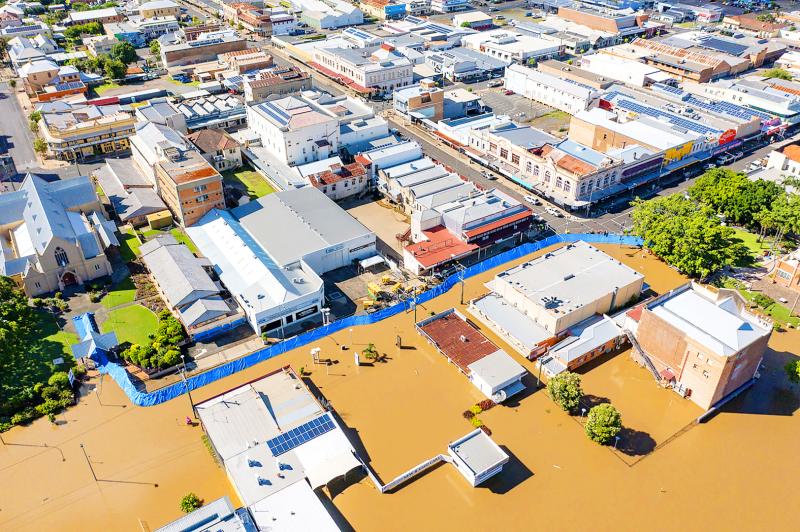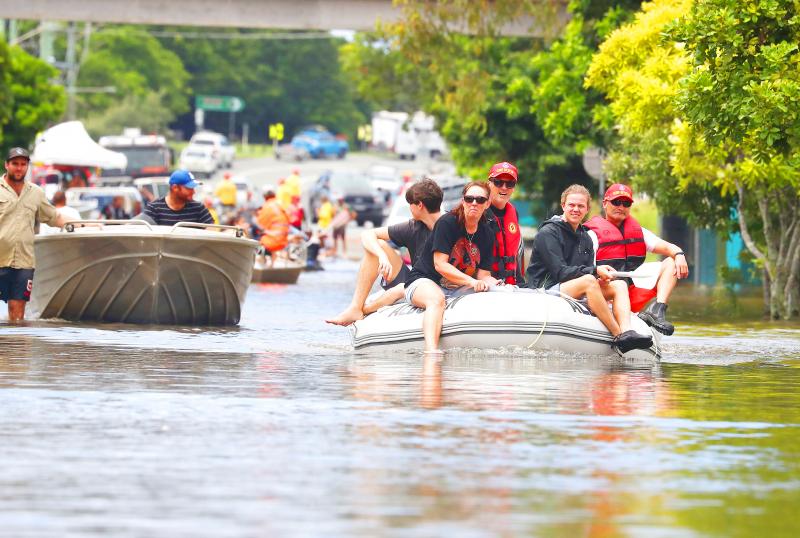Tens of thousands of people had been ordered to evacuate their homes by yesterday and many more had been told to prepare to flee as parts of Australia’s southeast coast were inundated by the worst flooding in decades that has claimed at least nine lives.
Scores of residents, some with pets, spent hours trapped on their roofs in the past few days by a fast-rising river in the town of Lismore in northern New South Wales state.
The body of a woman in her 80s was yesterday found by a neighbor in her Lismore home, a police statement said. There were no details of how she died.

MANHOLE TRAP
There were concerns that householders who climbed into their roof spaces through ceiling manholes could become trapped by rising waters.
A police rescue officer had saved an elderly woman from such a roof space that was almost filled with water, Lismore State Emergency Service Commander Steve Patterson said.

“He dived in through a window, noticed the manhole cover was open, when he checked, found a 93-year-old lady with about 20cm left of space before the water hit the top,” Patterson told Australian Broadcasting Corp.
Dozens of vehicles were trapped on a bridge in the nearby town of Woodburn over Monday night with both the bridge’s approaches submerged.
Up to 50 people were rescued from the bridge early yesterday, officials said.
“We had no capabilities to get them off in the dark so we just had to make sure that they bunkered down, and we went in this morning and got them all out,” Woodburn State Emergency Services Commander Ashley Slapp said.
The flood waters were moving south into New South Wales from Queensland state in the worst disaster in the region since what was described as a once-in-a-century event in 2011.
New South Wales Premier Dominic Perrottet said there had been 1,000 rescues in his state by yesterday and more than 6,000 calls for authorities to help.
Perrottet said 40,000 people had been ordered to evacuate, while 300,000 others had been placed under evacuation warnings.
“We’ll be doing everything ... We can to get everybody to safety and get these communities right across our state back on their feet as quickly as possible,” Perrottet said.
Government meteorologist Jonathan Howe described the amount of recent rainfall in northern New South Wales and southern Queensland as “astronomical.”
Eight of the nine deaths of the current disaster were in Queensland.
Queensland Police Commissioner Katarina Carroll said emergency services held grave concerns for a man aged in his 70s who fell from his moored yacht in the state capital, Brisbane ,into a swollen river on Saturday and for a 76-year-old man who disappeared with his vehicle in flood water northwest of Brisbane on Sunday.
FIRE RISK
The extraordinary rainfall comes as the UN Intergovernmental Panel on Climate Change (IPCC) reported this week that vast swathes of Australia have already lost 20 percent of its rainfall and the country’s fire risk has gone beyond worst-case scenarios developed just a few years ago.
Australia’s hottest and driest year on record was 2019, which ended with devastating wildfires across southeast Australia.
The fires directly killed 33 people and another 400 people were killed by the smoke.
The fires also destroyed more than 3,000 homes and razed 19 million hectares of farmland and forests.
However, two La Nina weather patterns have since brought above-average rainfall to the same regions.
Lesley Hughes, an Australian academic and former lead author of the IPCC assessment reports in 2007 and 2015, said climate change was expected to overwhelm government systems such as flood responses.
“We can see that our emergency services are struggling already to cope with the floods in northern New South Wales with people stranded on roofs without food for more than 24 hours,” Hughes said.